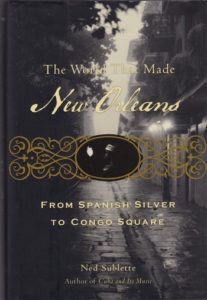
Ned Sublette wrote The World That Made New Orleans: From Spanish Silver to Congo Square (Lawrence Hill Books, 2009), a delightful, enlightening piece combining cultural and political history of the Crescent City. Anyone who loves the city should read the book.
Next week at this time, Mardi Gras or Fat Tuesday will be over for 2018. The season of Lent then begins. The noisy crowds will slowly leave New Orleans, tons of trash will be dumped somewhere, and streets will be washed down. But the music, dance, and theater so loved in the city continue.
In a city that survived three European regimes in the 17th and 18th centuries, today it welcomes and entertains the entire world. The French came first, bringing their language and Catholic religion. Their most prosperous territory at first was along the rivers and streams of the Great Lakes and Canada. Since they claimed all headwaters of the Mississippi River, the port at New Orleans became a place of interest for slave traders. While New Orleans did not rank with Havana or other Caribbean ports for the slave trade, numerous African nationalities and cultures found a home in the city. As the French learned how to grow and export sugar, lands in what is now Louisiana became sugar plantations. The intensive labor cut short all lives and required more and more slaves.
Slaves entering New Orleans came from Ouidah, Senegal and Angola. The French officials allowed them to keep their language, music, foods, religion and other cultural identifiers. Gradually those slaves from Angola gravitated to an area known as Congo Square on Sundays where dancing and music continued all day and into the night. Later groups joined with music subtlely differently according to their African homeland.
In the 1760s Great Britain conquered Canada. Groups of French speaking Canadians known as Acadians or Cajuns as they would eventually be called were deported to the French territory around New Orleans. It was in the area southwest of the city that a new form of music began – Cajun music. As lively and rhythmic as African music, Cajun music has a special place in New Orleans.
New Orleans was always a source of mystery and intrigue, especially during the Spanish rule. A political deal involving Napoleon and the Spanish government briefly and not very successfully handed over New Orleans to the Spaniards. During this time, one of the United States’ greatest artists in treason, General James Wilkinson served as Commander in Chief of the U. S. Army as well as Agent 13 in the Spanish Secret Service. Many believe that Wilkinson was involved in the attempted filibuster of Texas by Aaron Burr.
However, the French were able to regain control of New Orleans in the late 1790s. In 1803 President Thomas Jefferson negotiated the purchase of a vast amount of land in the watershed of the Mississippi River. Spanish and Americans were not as lenient with the slave population as the French had been. All cultural identifiers were abolished; English became the language of all slaves, no matter their origin. Yet, New Orleans retained its cultural, musical, and epicurean heritage proudly.
